Processing VIMS cubes, An attempt at "true" color |

  |
Processing VIMS cubes, An attempt at "true" color |
 Sep 16 2006, 09:37 PM Sep 16 2006, 09:37 PM
Post
#31
|
||
 Senior Member     Group: Members Posts: 3648 Joined: 1-October 05 From: Croatia Member No.: 523 |
I hope you don't feel I am being discouraging. Not at all. There's generally just too much "mystique" about gamma that I rather not mess around with it. Here's a literal implementation of a 1/2.2 power function in the code: 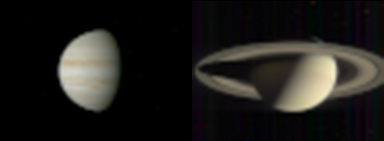 The above shows nicely why I'm not too fond of gamma manipulations -- the terminator comes out too sharp (you don't get the feeling Jupiter is actually 3D), the colors and contrast are bleached, and it also brings out an ever-present non-dark background. Hmm... or maybe that means I have to calibrate my monitor... Here's that Saturn mosaic again: -------------------- |
|
|
|
||
| Guest_DonPMitchell_* |
 Sep 17 2006, 04:17 AM Sep 17 2006, 04:17 AM
Post
#32
|
|
Guests |
Here's a literal implementation of a 1/2.2 power function in the code: The real-life scene is probably not as saturated with color as a lot of photos show. Your gamma 2.2 images don't look like anything is going wrong in the software at all. I thought perhaps you were seeing something way off. |
|
|
|
 Sep 17 2006, 04:44 PM Sep 17 2006, 04:44 PM
Post
#33
|
||||||
 Senior Member     Group: Members Posts: 3648 Joined: 1-October 05 From: Croatia Member No.: 523 |
A couple of rough Saturn mosaics:
The blob in the middle image is Tethys. Ring mosaics: All images magnified 2x and gamma-corrected. -------------------- |
|||||
|
|
||||||
 Sep 17 2006, 07:17 PM Sep 17 2006, 07:17 PM
Post
#34
|
|
 Member    Group: Members Posts: 241 Joined: 22-August 05 From: Stockholm Sweden Member No.: 468 |
I think it looks great. Very subtle beautiful colors.
Keep em coming! /M |
|
|
|
 Sep 19 2006, 05:21 PM Sep 19 2006, 05:21 PM
Post
#35
|
|
 Senior Member     Group: Members Posts: 3648 Joined: 1-October 05 From: Croatia Member No.: 523 |
A few Jupiter images, fixed the greenish hue. It was due to my code subtracting out dark background when apparently it was already subtracted from the Jupiter flyby cubes.
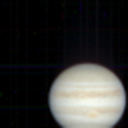 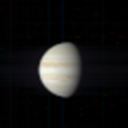  The middle and right image were taken not far apart, the rightmost image is much bigger because it utilized a high-resolution mode developed in-flight, it increases the spatial resolution by 3x at a cost of lowering the S/N ratio a bit. The leftmost image is also hi-res, but was taken far before closest approach. Outbound crescent, 2 cube mosaic: 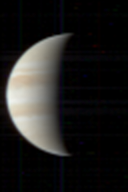 A couple of Europa transits: 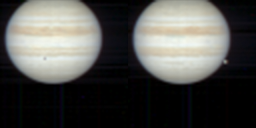 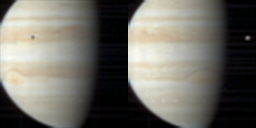 It's a shame the transit on the right didn't catch more area to the left of Jupiter's limb, there was a great grouping of Io and Ganymede there. The rightmost image is actually very close in time to an ISS narrow-angle sequence, taken on January 2nd, 2001. Again, all images magnified 2x and gamma-corrected. -------------------- |
|
|
|
 Sep 19 2006, 07:23 PM Sep 19 2006, 07:23 PM
Post
#36
|
|
 Member    Group: Members Posts: 241 Joined: 22-August 05 From: Stockholm Sweden Member No.: 468 |
A few Jupiter images, fixed the greenish hue. It was due to my code subtracting out dark background when apparently it was already subtracted from the Jupiter flyby cubes. Just for the sake of inconsistensy I think it looks great. Fantastic actually. If i had to pick on something i would have to mention the almost invisible residual pattern in the images. faint thin horizontal and vertical lines. some of them seem to show up at the same place in all the images. (sometimes rotated 90 degrees but i guess thats you rotating the images for display) others seem more random. is this due to sensor sensitivity variation and/or does it have to do with the scanning process of the instrument? Do you write your image processing software for some standard platform (IDL or something) or do you write totally standalone code? /M |
|
|
|
 Sep 19 2006, 07:37 PM Sep 19 2006, 07:37 PM
Post
#37
|
|
 Senior Member     Group: Members Posts: 3648 Joined: 1-October 05 From: Croatia Member No.: 523 |
The vertical stripes (most noticeable is a blue line) in some darker shots... I've checked and double-checked the flatfields and dark background removal code and none of them even touches that. There's a load of them in the raw data, they appear to be static so those are probably hot pixels on the CCD. Since the cubes are readout one line at a time, in a push-broom mode with the spectra of the line being split in the vertical dimension, It means same samples in all lines in a given spectral band will suffer from the same problem. Hence the vertical lines. What I don't understand is why adequate flatfields/dark current models haven't been produced to deal with this. This only affects the visible channel, the IR channel seems fine (note the VIS and IR channels are actually two different physical parts). So far, there's nothing I can do about it.
The code is an ad-hoc implementation in C, it's rudimentary and messy as I progressively modified it from simply trying to read the cubes to do more complex stuff like color matching. It doesn't even output a nice PNG color image, but a raw 64x64 pixel dump with 3 interleaved rgb channels -------------------- |
|
|
|
 Sep 19 2006, 08:16 PM Sep 19 2006, 08:16 PM
Post
#38
|
|
 Member    Group: Members Posts: 241 Joined: 22-August 05 From: Stockholm Sweden Member No.: 468 |
I guess you have to make an additional flatfield removal using a homebrewn flatfield. Try simply takeing one row of an image of black space, scale to width of image and remove it from the data and see what it looks like.
/M |
|
|
|
 Sep 19 2006, 08:18 PM Sep 19 2006, 08:18 PM
Post
#39
|
|
 Interplanetary Dumpster Diver     Group: Admin Posts: 4404 Joined: 17-February 04 From: Powell, TN Member No.: 33 |
Great work! As for the calibration data, it could be that they are still working on it. A lot of these things weren't worked out at the time of the Jupiter encounter. It might be worth contactings someone to find out.
-------------------- |
|
|
|
 Sep 20 2006, 07:24 AM Sep 20 2006, 07:24 AM
Post
#40
|
|
 Senior Member     Group: Members Posts: 3648 Joined: 1-October 05 From: Croatia Member No.: 523 |
I guess you have to make an additional flatfield removal using a homebrewn flatfield. Try simply takeing one row of an image of black space, scale to width of image and remove it from the data and see what it looks like. I don't think it's a flatfield problem. Flatfields only correct for varying sensitivity of different pixels. This appears to be primarily a dark current problem - you can see the lines even in dark space which flatfields can't remove. Remember, you divide or multiply the image with a flatfield. This, on the other hand, will obviously need subtracting out. I don't even know where to begin modelling dark current data. The provided dark current model uses a two-parameter table, one a standalone part and the other a variable part multiplied by exposure, for each CCD pixel. The model seems fine for normal resolution cubes (though even that doesn't completely remove everything), but the hi-res one seems buggy. Furthermore, these Jupiter images where the dark was subtracted by the instrument itself show no apparent signs of those nasty lines. Then again, this could be due to the fact Jupiter images took a 4 times shorter exposure than Saturn targets, because of increased light levels there so dark current didn't have as much time to build up. A document on the PDS says new models are generated every month or so, but it looks to me the same tables appear on all 8 VIMS DVDs. I mailed one of the guys responsible for the PDS volumes so we'll see what they have to say. -------------------- |
|
|
|
 Sep 20 2006, 08:48 AM Sep 20 2006, 08:48 AM
Post
#41
|
|
 Member    Group: Members Posts: 241 Joined: 22-August 05 From: Stockholm Sweden Member No.: 468 |
it was a typo. i actually ment darkcurrent. mixed them up in my head for some reason. (thats why i suggested you to use a bit of black space to serve as a DC remover)
|
|
|
|
 Sep 20 2006, 09:22 AM Sep 20 2006, 09:22 AM
Post
#42
|
|
 Senior Member     Group: Members Posts: 3648 Joined: 1-October 05 From: Croatia Member No.: 523 |
Although the noise stays fixed, it changes intensity -- it's likely connected with exposure duration. It's not likely to be as easy as subtracting a generic dark cube from all cubes. I don't think a small bit of dark space would do the trick as there's also a fair bit of cosmic ray noise induced. It would be required to average many dark lines. There are many dark space cubes that weren't even readout as a full 64 width swath so they're of limited usefulness. Additionally, the physical resolution of the CCD is AFAIK 192x96 pixels with 192 being one spatial line and 96 being the visible spectral channels. All cubes have a maximum resolution of 64 spatial pixels. Normal mode of operation simply sums three pixels in a line to get 192/3=64 pixels. The high res mode, however doesn't sum the individual pixels and that's where the 3x resoulution increase comes from. This is where it gets complicated a bit: which 64 pixels out of 192 will be readout depends upon the offset factors and is somewhat clumsy. A fair bit of margin for error is present if you don't know exactly what you're doing. The PDS document isn't all too clear on certain aspects.
Which brings me to the point -- if this is as simple as we suggest, why didn't the VIMS folks do this in the first place? This noise problem must have been known at least since Saturn orbit insertion. IMHO, it's not up to us to fix the calibration and produce our own files that do basic stuff like dark current removal. Of course, all this is barring I haven't screwed up in my code somewhere, but I'm more and more certain that's not the case. -------------------- |
|
|
|
 Sep 20 2006, 11:34 AM Sep 20 2006, 11:34 AM
Post
#43
|
|
 Senior Member     Group: Members Posts: 3648 Joined: 1-October 05 From: Croatia Member No.: 523 |
Not particularly related to my processing, but here are a couple of past releases by the VIMS team of Jupiter results and Titan results. The Jupiter page shows the same image as my bottom 2nd image from the right. Their image was mirrored left-right as Cassini never saw Jupiter from that vantage point. The dark spot on Jupiter's disc is not Io's shadow as they suggest, it's Europa. They used a simple 3-channel RGB composite, but it's notable there's some vertical banding present in their data as well. This is not the same noise we were discussing here, though. It's more likely artifacts during the scanning mirror uneven movement and different lines were unevenly exposed hence the brightness gradient.
The Titan page I bring up because it does show the ugly vertical lines -- note the false color composite labeled "VIS channel". Seems they were unable to remove it as well. -------------------- |
|
|
|
 Sep 20 2006, 03:23 PM Sep 20 2006, 03:23 PM
Post
#44
|
|
 Member    Group: Members Posts: 241 Joined: 22-August 05 From: Stockholm Sweden Member No.: 468 |
Which brings me to the point -- if this is as simple as we suggest, why didn't the VIMS folks do this in the first place? This noise problem must have been known at least since Saturn orbit insertion. IMHO, it's not up to us to fix the calibration and produce our own files that do basic stuff like dark current removal. it is a quick and dirty trick. in theory if you shoot an image of a planet and then of black space (or with the lens cap on) with identical settings it should create a perfect darkcurrent image. problem is that it would be noisy. so you would need a few black images to average out the noice. problem is that Cassini would have to send back lets say 5 black images for each "real" image. leading to an extreme waste of downlink time and other issues like SSR space and stuff. I guess thats why they make a mathematical model of the darkcurrent instead. I think that it is up to us to fix some of the calibration issues. the 2hz banding in the ISS images can be removed in lots of ways. its really hard to remove it completly. one way is to use the edge pixels that have not been exposed to light to create a DC image. Another way is to use that data to fit some kind of sinus wave to it and create a DC image from the sinus wave. another way is to use the pixelrows that are black space in an image to create a DC image. or fit a sinus wave to that. or combinations of these methods. or some fourier filter or some other magic. Maybe its the same way with these VIMS lines. they might be really hard to model exactly. and that its up to the user to choose a way that fits him/her. /M |
|
|
|
 Sep 20 2006, 07:38 PM Sep 20 2006, 07:38 PM
Post
#45
|
|
 Senior Member     Group: Members Posts: 3648 Joined: 1-October 05 From: Croatia Member No.: 523 |
Here are a couple of... hm... questionable(?) results.
First, a wholly unremarkable image -- three narrow strips taken during Cassini's second Venus flyby: 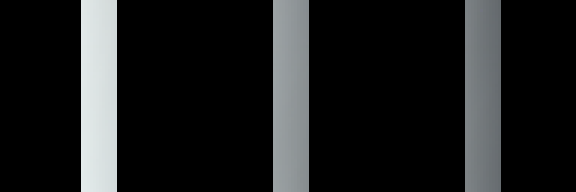 Their relative spacing isn't meaningful, it's just 3 cubes stacked together. Magnified 3x. I don't know exactly where VIMS was pointed at the time, but my best guess by looking at the PDS data is that it was practically nadir, seeing near-equatorial latitudes. This was near C/A, distance was around 8800 km to Venus' center (it appeared huge in the FOV so no cloud details could be seen here - the vertical scale was about 2 degrees latitude on Venus) and the phase angle was about 90 degrees. That's why I presume the three images show the terminator at right and dayside at left. I was under the impression Venus was yellowish-white, but this turned out bluish. Note that VIMS was far from its normal operating temperatures so maybe the sensitivity was influenced and the results could be way off. The exposure used was only 50 ms, as opposed to exposures at Saturn being typically 5000 ms and more. Any calibration uncertainties would likely be exaggerated here. I'd be interested to hear what Don thinks about this, being a Venus expert and all... EDIT: Again, referencing to an official Venus flyby page, they also got a bluish Venus, though using only simple rgb channels. That's also the reason their image turned out so noisy. Second, a Moon image, super-resolution view of 4 cubes stacked together:  Again, I'm surprised by the way the image turned out. I'd expect the Moon to turn out gray, but this is more like that Mariner spacecraft composite of Earth and the Moon. Or some of the Apollo shots. The image in the middle is a Solar System Simulator view, blurred to get the same effective resolution. The rightmost image is the same simulated image, unblurred. The VIMS composite was magnified 4 times. Yes, four! You can really see how VIMS traded off spatial for spectral resolution. This post has been edited by ugordan: Sep 20 2006, 07:46 PM -------------------- |
|
|
|
  |

|
Lo-Fi Version | Time is now: 18th April 2024 - 12:20 PM |
|
RULES AND GUIDELINES Please read the Forum Rules and Guidelines before posting. IMAGE COPYRIGHT |
OPINIONS AND MODERATION Opinions expressed on UnmannedSpaceflight.com are those of the individual posters and do not necessarily reflect the opinions of UnmannedSpaceflight.com or The Planetary Society. The all-volunteer UnmannedSpaceflight.com moderation team is wholly independent of The Planetary Society. The Planetary Society has no influence over decisions made by the UnmannedSpaceflight.com moderators. |
SUPPORT THE FORUM Unmannedspaceflight.com is funded by the Planetary Society. Please consider supporting our work and many other projects by donating to the Society or becoming a member. |

|